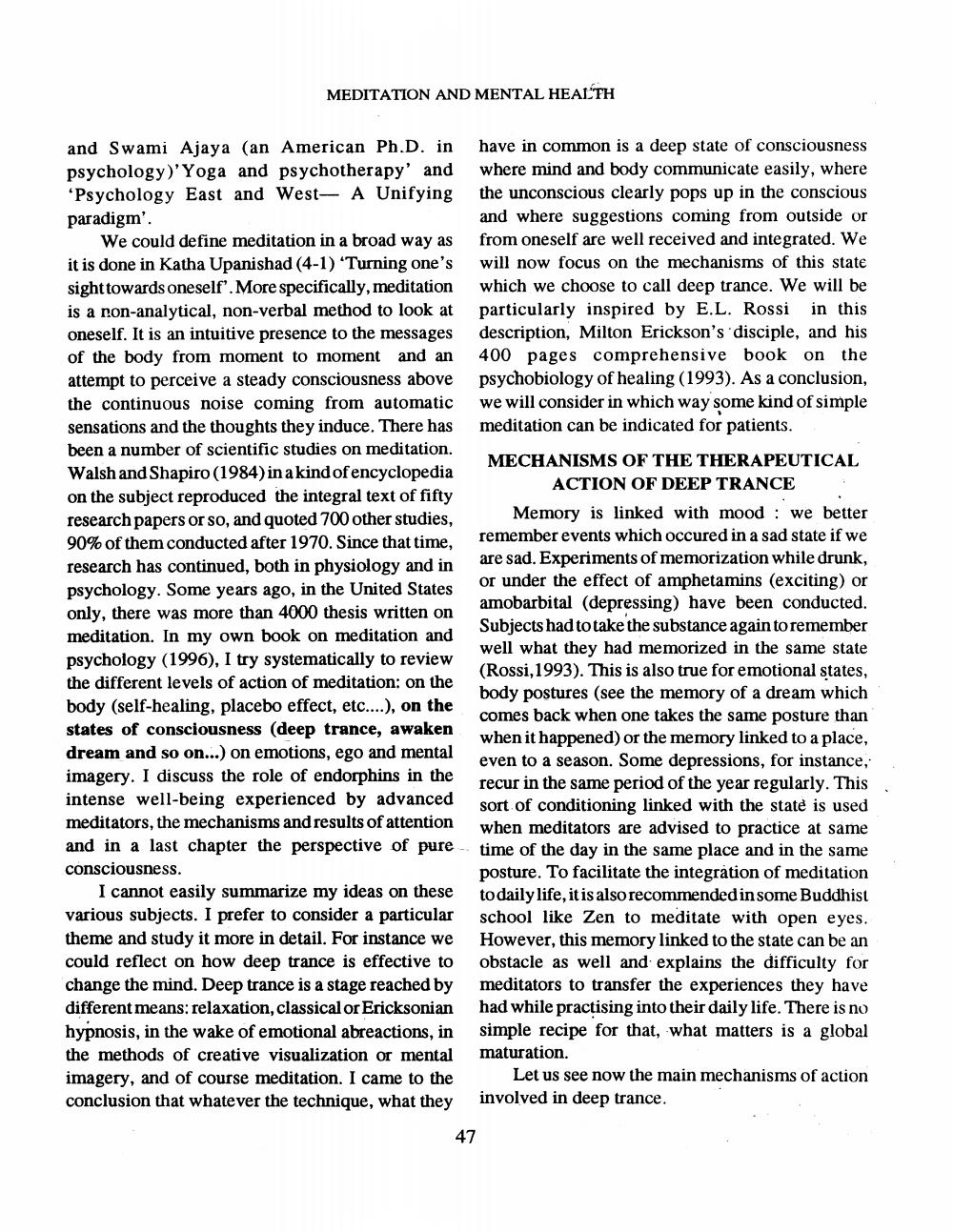________________ MEDITATION AND MENTAL H and Swami Ajaya (an American Ph.D. in have in common is a deep state of consciousness psychology)'Yoga and psychotherapy' and where mind and body communicate easily, where 'Psychology East and West - A Unifying the unconscious clearly pops up in the conscious paradigm'. and where suggestions coming from outside or We could define meditation in a broad way as from oneself are well received and integrated. We it is done in Katha Upanishad (4-1) 'Turning one's will now focus on the mechanisms of this state sight towards oneself'. More specifically, meditation which we choose to call deep trance. We will be is a non-analytical, non-verbal method to look at particularly inspired by E.L. Rossi in this oneself. It is an intuitive presence to the messages description, Milton Erickson's disciple, and his of the body from moment to moment and an 400 pages comprehensive book on the attempt to perceive a steady consciousness above psychobiology of healing (1993). As a conclusion, the continuous noise coming from automatic we will consider in which way some kind of simple sensations and the thoughts they induce. There has meditation can be indicated for patients. been a number of scientific studies on meditation. MECHANISMS OF THE THERAPEUTICAL Walsh and Shapiro (1984) in a kind of encyclopedia ACTION OF DEEP TRANCE on the subject reproduced the integral text of fifty research papers or so, and quoted 700 other studies, Memory is linked with mood : we better 90% of them conducted after 1970. Since that time, remember events which occured in a sad state if we research has continued, both in physiology and in are sad. Experiments of memorization while drunk, or under the effect of amphetamins (exciting) or psychology. Some years ago, in the United States amobarbital (depressing) have been conducted. only, there was more than 4000 thesis written on Subjects had to take the substance again to remember meditation. In my own book on meditation and well what they had memorized in the same state psychology (1996), I try systematically to review (Rossi, 1993). This is also true for emotional states, the different levels of action of meditation: on the body postures (see the memory of a dream which body (self-healing, placebo effect, etc....), on the comes back when one takes the same posture than states of consciousness (deep trance, awaken when it happened) or the memory linked to a place, dream and so on...) on emotions, ego and mental even to a season. Some depressions, for instance, imagery. I discuss the role of endorphins in the recur in the same period of the year regularly. This intense well-being experienced by advanced sort of conditioning linked with the state is used meditators, the mechanisms and results of attention when meditators are advised to practice at same and in a last chapter the perspective of pure - time of the day in the same place and in the same consciousness. posture. To facilitate the integration of meditation I cannot easily summarize my ideas on these to daily life, it is also recommended in some Buddhist various subjects. I prefer to consider a particular school like Zen to meditate with open eyes. theme and study it more in detail. For instance we However, this memory linked to the state can be an could reflect on how deep trance is effective to obstacle as well and explains the difficulty for change the mind. Deep trance is a stage reached by meditators to transfer the experiences they have different means: relaxation, classical or Ericksonian had while practising into their daily life. There is no hypnosis, in the wake of emotional abreactions, in simple recipe for that, what matters is a global the methods of creative visualization or mental maturation. imagery, and of course meditation. I came to the Let us see now the main mechanisms of action conclusion that whatever the technique, what they involved in deep trance. 47




